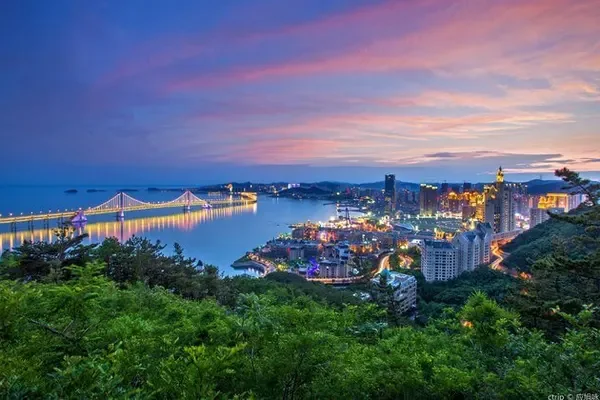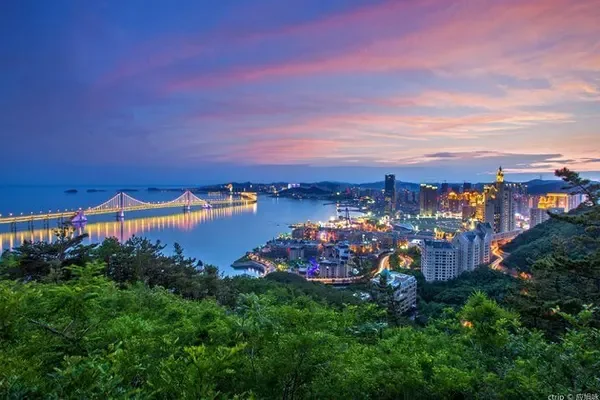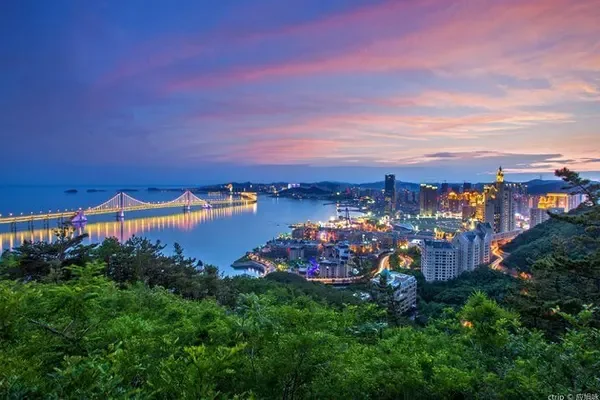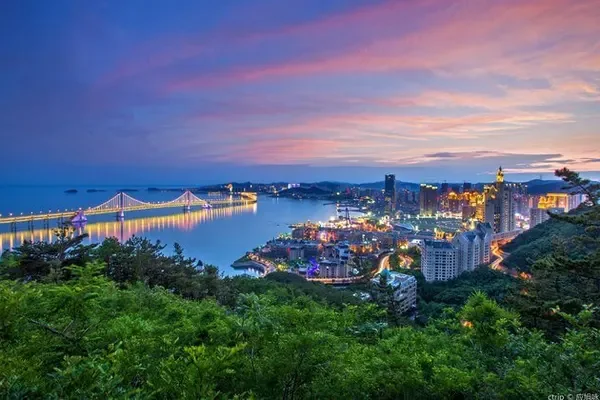
The Forbidden City in Beijing is the royal palace of the Ming and Qing dynasties in China. It used to be called the Forbidden City and is located in the center of the central axis of Beijing. The Forbidden City in Beijing is centered on three main halls, covering an area of 720,000 square meters, with a construction area of about 150,000 square meters. There are more than 70 palaces of different sizes and more than 9,000 houses.

The Forbidden City is a rectangular city, 961 meters long from north to south, 753 meters wide from east to west, surrounded by walls 10 meters high, and a moat 52 meters wide outside the city.

The Forbidden City has four gates, the main gate is called Meridian Gate, and its plane is concave. After the Meridian Gate, there are five white marble arch bridges leading to the Taihe Gate. The east gate is named Donghua Gate, the west gate is named Xihua Gate, and the north gate is named Shenwu Gate. There are turrets in the four corners of the Forbidden City, with a height of 27.5 meters and a cross roof.


The Meridian Gate is the main entrance of the Forbidden City. Commonly known as Wufeng Tower. The east, west and north sides are connected by a 12-meter-high city platform, surrounding a square square. The entire city gate has gone through hundreds of years of vicissitudes, and it is still proud of the world, which makes people admire. The Meridian Gate is the place where the emperor issued edicts and ordered expeditions. Whenever the imperial decree of the emperor is read out and the almanac is issued, all civil and military officials must gather in the square in front of the Meridian Gate to listen to the decree. The main gate in the Meridian Gate is usually only the emperor can enter and exit. The empress enters once when the emperor is married, and the three people who have won the first prize, the second place, and the best in the palace examination can walk out from this gate once.

The Donghua Gate and Xihua Gate correspond to each other. There is a stele for dismounting the horse outside the gate. Inside the gate, the Jinshui River flows north-to-north. There is a stone bridge above the gate, and there are three gates in the north of the bridge. Donghua Gate and Xihua Gate have the same shape, with a rectangular plane, a red city platform, and a white jade Xumi seat. There are 3 voucher gates in the middle, and the voucher holes are square outside and circle inside. There is a city tower on the city platform, with yellow glazed tiles and double eaves on the roof. The tower is 5 rooms wide and 3 rooms deep, with corridors around it. Ministers of civil and military affairs enter and exit the east door, and clan princes enter and exit the west door.

The Forbidden City is a symbol of imperial power in the Ming and Qing dynasties. It has a history of 600 years, and 24 emperors of the Ming and Qing Dynasties have ruled China here for more than 500 years.

The construction of the Forbidden City was an act of deifying imperial power by the emperors in the feudal society at that time, and it was also the crystallization of the wisdom of the industrious and brave Chinese people.

After 14 years of construction, the Forbidden City was finally completed in the eighteenth year of Yongle (1420) in the Ming Dynasty. Its completion embodies the blood and lives of countless hardworking people.


The only feeling after entering from the Meridian Gate is grandeur and vastness. Stepping into this sacred land is filled with pride and admiration for the wisdom of our ancestors. I feel that every brick and tile here is telling the history and telling its past glory.

The Forbidden City in Beijing, its huge momentum is shocking, and it really feels like seeing it late.

There are two iron tanks in front of the gate, which are fireproof and filled with water.

The buildings in the Forbidden City are divided into two parts: the outer court and the inner court. The center of the Outer Dynasty is the Hall of Supreme Harmony, the Hall of Central Harmony, and the Hall of Preserving Harmony, collectively referred to as the Three Great Halls, where the state holds grand ceremonies.

The Forbidden City, in ancient China, paid attention to the planning concept of "harmony between man and nature", and used the stars in the sky to correspond to the planning of the capital to highlight the legitimacy of the regime and the supremacy of imperial power. Since the feudal imperial palace was a forbidden place in ancient times, ordinary people could not enter it, so it was called "Forbidden City". In the early Ming Dynasty, it was collectively referred to as the "Imperial City" together with the Outer Forbidden City. Around the middle and late Ming Dynasty, it was distinguished from the Outer Forbidden City.

The palace at the front of the Forbidden City required a magnificent architectural style at that time, and the courtyard was bright and open, symbolizing the supremacy of the feudal regime. The Hall of Supreme Harmony is located in the center of the diagonal line of the Forbidden City, and there are ten auspicious beasts on each of the four corners. The designers of the Forbidden City think that this is to show the majesty of the emperor and frighten the world. The inner court at the rear requires depth and compactness, so the six east and west palaces are all self-contained, each with its own palace gate and palace wall, arranged relative to each other in an orderly manner. After the inner court is the palace garden.

The entire building of the Forbidden City is resplendent and majestic. It is known as one of the five major palaces in the world (the Forbidden City in Beijing, the Palace of Versailles in France, Buckingham Palace in the United Kingdom, the White House in the United States, and the Kremlin in Russia). It is also listed as a "world cultural heritage" by UNESCO.


I think the most amazing thing is the sundial. The original meaning of sundial refers to the shadow of the sun, so the ancients used the sun's shadow to measure the time, and the sundial is an ancient timekeeping instrument. When the sundial is irradiated by the sun, the length and direction of the shadow are constantly changing, so it can be used to see the angle between the sundial plane and the sundial, which happens to be the local latitude.

There are two copper tortoises and copper cranes in front of the Hall of Supreme Harmony, symbolizing longevity and boundless longevity.


No trees were planted in the previous dynasty of the Forbidden City. One is because the buildings in the Forbidden City are all wooden structures, trees are easy to catch fire in case of fire, and thunderstorms in rainy days are dangerous; Fourth, from a superstitious point of view, the Forbidden City is in the shape of a "mouth", and if trees are planted, it will become a "sleepy" character. Not planting trees is to prevent the emperor from being trapped.

In terms of architectural layout, the entire Forbidden City is combined into a whole by means of shape changes and ups and downs, which conforms to the hierarchical system of feudal society in terms of function. At the same time, the artistic effect of left-right balance and shape change can be achieved.




I walked among the magnificent ancient buildings. The red walls and yellow tiles let us feel the vicissitudes of history. The blue bricks and reliefs made me dizzy: the golden unicorns, cranes, old turtles and other animals carved out are lifelike and lifelike, symbolizing With auspiciousness and majesty.

After the baptism of history, the three halls are more simple, solemn and dignified, as if the situation in the world has been fully seen, and you can look at the misty world of mortals and stand aloof from the world.

The roof forms of Chinese architecture are rich and colorful. In the buildings of the Forbidden City, there are more than 10 different forms of roofs. Taking the three halls as an example, the roofs are different. The roof of the Forbidden City is covered with glazed tiles of various colors.




The center of the inner court is Qianqing Palace, Jiaotai Palace, and Kunning Palace, collectively referred to as the Housan Palace, which is the main palace where the emperor and empress live.

The second half of the Forbidden City is called the Inner Court. The gate of the Inner Court Palace, the Qianqing Gate, has glazed screen walls on the left and right, and the rear three palaces are inside the gate. The inner court is centered on Qianqing Palace, Jiaotai Palace, and Kunning Palace. There are East Six Palaces and West Six Palaces on the east and west wings. It is the place where the emperor handles daily government affairs and where the emperor and his concubines live. The second half is architecturally different from the first half. The first half of the building symbolizes the supremacy of the emperor. Most of the inner court buildings in the second half are self-contained courtyards.





The inner court courtyard is deep and the buildings are compact. In the back garden, there are green pines and cypresses that never fade through the years, and exquisite rockery built with beautiful stones.


Royal garden. In the park, there are many rockery and strange stones, pavilions, towers and pavilions, and ancient trees soaring into the clouds, creating a scene of prosperity and prosperity.


An imperial garden, after a hundred years of romance and turmoil, is still beautiful and moving.












The Treasures Museum of the Palace Museum is located in the east of the Palace Museum. The Treasure Hall is a treasure house, with gems of various colors, gleaming gold and silver vessels, pearls and emeralds, as well as golden silk phoenix crowns, ivory and jade carvings, all kinds of treasures are unparalleled in the world.

On the Nine Dragon Wall, there are indeed nine dragons of different shapes crouching on the wall, each with its own spirit and spirit, and each with outstanding demeanor, which makes people stop and linger and have endless aftertaste.





Most of the palace treasures of the Qing Dynasty collected by the Palace Museum were made by order of the construction institution in the Forbidden City - the Construction Office, and some were tributes from local officials during New Year celebrations. Most of these treasures are made of precious materials such as gold, silver, jade, emerald, pearls and various gemstones, and are designed and manufactured by famous craftsmen from all over the country. highest level. In terms of application, it widely involves activities in various fields such as court rules and rituals, religious sacrifices, daily life, leisure and entertainment, etc., showing the supremacy and dignity of imperial power everywhere, and the royal grace and elegance, which specifically and subtly reflect the spirit of that era. style.



In the Treasure Hall, there are royal treasures, each of which is unique in the world, regardless of aesthetic value, historical and cultural value, it is unique.



The significance of the palace treasures of the Qing Dynasty today has gone far beyond the value of simple materials and craftsmanship. They reflect the profound and profound heritage of traditional Chinese culture, are a vivid portrayal of that period of history, and are the brilliance formed by the condensation of national spirit. gem.






















Located in the Zhenshun Gate at the northern end of the Ningshou Palace of the Forbidden City in Beijing, it was originally an ordinary well in the palace. A wellhead stone is placed on the wellbore of Zhenfei Well, and small holes are cut on both sides of the stone to penetrate the iron rod and lock it. In the twenty-sixth year of Guangxu in Qing Dynasty (1900), the Eight-Power Allied Forces attacked the capital, and Empress Dowager Cixi and Emperor Guangxu fled westward in panic. Before leaving, the Empress Dowager Cixi summoned Concubine Zhen, who was imprisoned in the North Courtyard of Jingqi Pavilion, to Yihexuan, and ordered the eunuch Cui Yugui and others to push her into the inner well of Zhenshun Gate to drown, hence the name "Concubine Zhenjing". .

A simple building will not give people any feeling. Only after the baptism of time and personnel changes can it glow with brilliance. This is the charm of the Forbidden City.










Some people think that China's architectural culture is lifeless, not as glamorous as foreign castles and palaces. But they have a long history and rich cultural heritage, just like foreigners like diamonds with a radiant appearance, but Chinese people like smooth and soft jade. It is a restrained beauty, a quiet beauty, and a profound beauty. Therefore, we don't need to envy others, but to cherish what we have. The Forbidden City is the pride of the Chinese nation.



Architects believe that the design and construction of the Forbidden City is really an unparalleled masterpiece. Its plane layout, three-dimensional effect, and majestic, majestic, solemn, and harmonious form, the building is majestic, luxurious and magnificent. It is an ancient Chinese architectural art. essence. It symbolizes China's long cultural tradition and shows the outstanding architectural achievements of craftsmen more than 500 years ago.




After the founding of the People's Republic of China in 1949, large-scale renovations were carried out on the buildings of the Forbidden City, and a large number of cultural relics were sorted out at the same time. In 1961, the State Council promulgated the Forbidden City as a national key cultural relics protection unit. There are 1,862,690 pieces/sets of cultural relics in the Palace Museum (as of August 2019). In 1987, the Forbidden City was listed as a "World Cultural Heritage" by UNESCO, and it was designated as the "Palace Museum".

Shenwu Gate was called "Xuanwu Gate" in the Ming Dynasty. Xuanwu was one of the four ancient gods and beasts. From the perspective of orientation, the green dragon on the left, the white tiger on the right, the red bird in the front, and Xuanwu in the back. Name "Xuanwu". During the Kangxi period of the Qing Dynasty, it was renamed "Shenwumen" because of taboos. Shenwumen is also a city gate tower, with the highest-grade double-eaved hipped roof, but its main hall has only five bays and corridors, and there are no left and right wings extending forward, so it is lower than Meridian Gate in terms of shape. grade. The Shenwu Gate is the access control for daily entry and exit in the palace. Shenwumen is now the main entrance of the Palace Museum.

After visiting the Forbidden City, I can't help feeling admiration for an imperial city - the Forbidden City. It is not only a concentrated symbol of the feudal emperor's imperial power, but also the crystallization of the collective wisdom of ancient Chinese craftsmen: it not only shows the tragedy of the dynasty changing period, but also shows the life of singing and dancing during the peaceful and prosperous period; There are songs of joy, but also the sorrow of parting in the style of loneliness and helplessness... It has endless love stories that cannot be told clearly, and there are also endless stories of family and country that cannot be told. A city is a movie, a historical legend.



